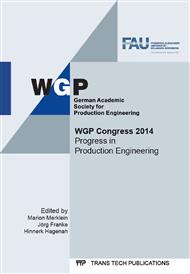[1]
J. Chae, S.S. Park, T. Freiheit, Investigation of micro-cutting operations, International Journal of Machine Tools and Manufacture 46 (2006) 313–332.
DOI: 10.1016/j.ijmachtools.2005.05.015
Google Scholar
[2]
D. Dornfeld, S. Min, Y. Takeuchi, Recent Advances in Mechanical Micromachining, CIRP Annals - Manufacturing Technology 55 (2006) 745–768.
DOI: 10.1016/j.cirp.2006.10.006
Google Scholar
[3]
T. Masuzawa, State of the Art of Micromachining, CIRP Annals - Manufacturing Technology 49 (2000) 473–488.
DOI: 10.1016/s0007-8506(07)63451-9
Google Scholar
[4]
J.C. Aurich, J. Engmann, M. Walk, Zerspanen mit Mikroschleifstiften, wt werkstattstechnik online 100 (2010) 832–836.
DOI: 10.37544/1436-4980-2010-11-12-832
Google Scholar
[5]
A. Wenda, Schleifen von Mikrostrukturen in sprödharten Werkstoffen, Schriftenreihe des Instituts für Werkzeugmaschinen und Fertigungstechnik der TU Braunschweig (2002).
Google Scholar
[6]
E. Brinksmeier, Y. Mutlugünes, F. Klocke, J.C. Aurich, P. Shore, H. Ohmori, Ultra-precision grinding, CIRP Annals - Manufacturing Technology 59 (2010) 652–671.
DOI: 10.1016/j.cirp.2010.05.001
Google Scholar
[7]
P.N. Blake, R.O. Scattergood, Ductile-Regime Machining of Germanium and Silicon, J American Ceramic Society 73 (1990) 949–957.
DOI: 10.1111/j.1151-2916.1990.tb05142.x
Google Scholar
[8]
W. Gu, Z Yao, H. Li, Investigation of grinding modes in horizontal surface grinding of optical glass BK7, Journal of Materials Processing Technology 211 (2011) 1629–1636.
DOI: 10.1016/j.jmatprotec.2011.05.006
Google Scholar
[9]
C. Barth, Dynamische Kontaktzonenvorgänge beim Schleifen sprödharter Werkstoffe, Produktionstechnische Berichte aus dem FBK, (2002).
Google Scholar
[10]
T.G. Bifano, T.A. Dow, R.O. Scattergood, Ductile-Regime Grinding: A New Technology for Machining Brittle Materials, J. Eng. for Industry 113 (1991) 184–189.
DOI: 10.1115/1.2899676
Google Scholar
[11]
B.R. Lawn, A.G. Evans, A model for crack initiation in elastic/plastic indentation fields, Journal of Materials Science 12 (1977) 2195–2199.
DOI: 10.1007/bf00552240
Google Scholar
[12]
H.K. Tönshoff, W. v. Schmieden, I. Inasaki, W. König, G. Spur, Abrasive Machining of Silicon, CIRP Annals - Manufacturing Technology 39 (1990)621–635.
DOI: 10.1016/s0007-8506(07)62999-0
Google Scholar
[13]
V.C. Venkatesh, I. Inasaki, H.K. Toenshof, T. Nakagawa, I.D. Marinescu, Observations on Polishing and Ultraprecision Machining of Semiconductor Substrate Materials, CIRP Annals - Manufacturing Technology 44 (1995) 611–618.
DOI: 10.1016/s0007-8506(07)60508-3
Google Scholar
[14]
Z. Zhong, V.C. Venkatesh, Semi-Ductile Grinding and Polishing of Ophthalmic Aspherics and Spherics, CIRP Annals - Manufacturing Technology 44 (1995) 339–342.
DOI: 10.1016/s0007-8506(07)62338-5
Google Scholar
[15]
J. Engmann, Galvanisch gebundene Mikroschleifstifte. Entwicklung, Herstellung und Einsatz, Produktionstechnische Berichte aus dem FBK, 01/(2011).
Google Scholar
[16]
J.C. Aurich, J. Engmann, G.M. Schueler, R. Haberland, Micro grinding tool for manufacture of complex structures in brittle materials, CIRP Annals - Manufacturing Technology 58 (2009) 311–314.
DOI: 10.1016/j.cirp.2009.03.049
Google Scholar
[17]
I.G. Reichenbach, M. Bohley, Micromachining of cp-titanium on a desktop machine – Study on bottom surface quality in micro end milling, Advanced Material Research 769 (2013) 53-60.
DOI: 10.4028/www.scientific.net/amr.769.53
Google Scholar
[18]
T.G. Bifano, Ductile-regime grinding of brittle materials, Dissertation, (1988).
Google Scholar
[19]
B. Denkena, H.K. Tönshoff, Spanen, 3., bear. U. erw. Aufl., Springer Verlag, (2011).
Google Scholar


